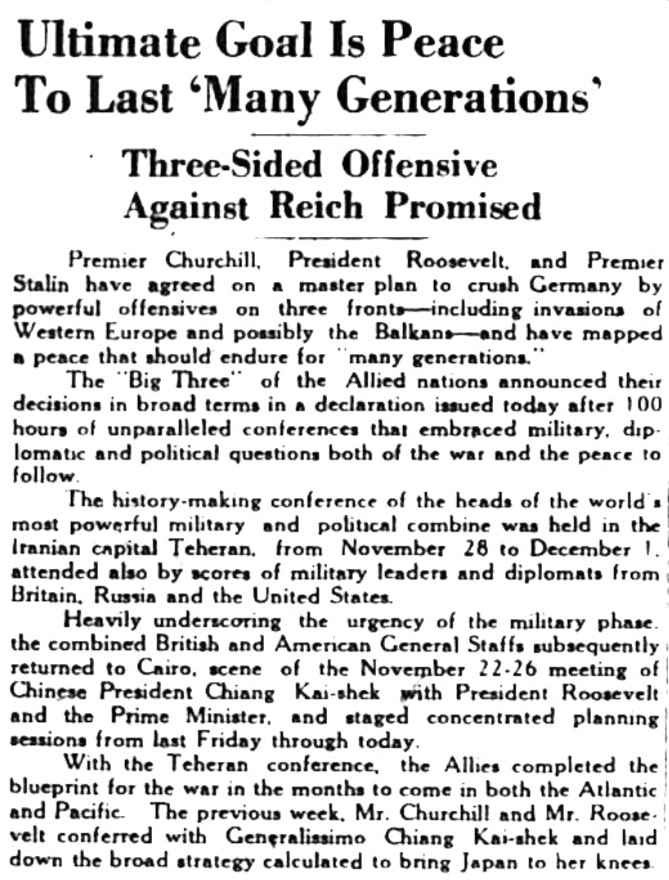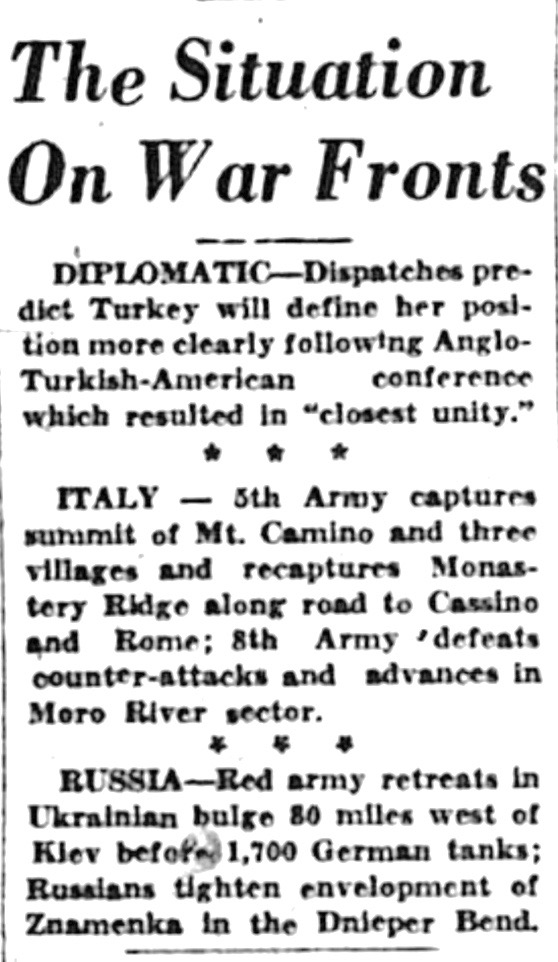Berlin is Getting Hit. Allies Advance in Italy
Victory is in the air, though 18 months in the future yet.
Introduction:
Canadians in Combined Operations were far from Italy; in fact, they returned home to Canada on December 6, 1943, aboard the Aquitania. Stepping onto dry ground in Halifax must have felt good to my father and many others like him, with actions in Dieppe, North Africa, Sicily and Italy now a thing of the past.
They are home, and I will scan December issues of The Montreal Star for more information about their work overseas that may have been delayed, or about their arrival in Halifax in December, or in their hometowns at a later date.
I do have four news reports that came out of Ottawa, Simcoe, London and Brantford about veterans' experiences overseas as members of RCNVR and Combined Operations. Veterans, including my father, were interviewed sometime in December, perhaps in January '44, while they were on a well-earned leave, and before they returned to service.
More news from December 5 - 8, 1943, will now follow from The Montreal Star. We lead off not with a headline, but with 'a love story' from the inside pages. :
A rare story above, and a rare photo below:
As readers can see, I do like posting ads from grocery stores, likely because I worked at a grocery store in my hometown for six years as a teenager. The price of eggs seems a little high - there was a war on, after all - but if you like beef liver, go for it.
The caption that accompanied the above photograph says:
From Switzerland comes this picture taken in a Berlin museum shortly after the mighty aerial assault on the German capital got under way. The scene is in the wrecked heroes Hall, porters carrying out besmoked uniformed dummies of national heroes. The wax dummies were rushed to safer resting places even as Nazi bigwigs were scurrying to less-bombed spots themselves.
* * * * *
The first two drafts of Canadian volunteers for Combined Operations (about 100 RCNVR ratings and a score of officers) travelled from Halifax to Greenock, Scotland in a convoy that likely assembled in Bedford Basin in January, 1942 before entering the Atlantic Ocean.
I have not come across any story that mentions a sailor taking out life insurance before leaving Canada, but I know that the first two drafts heard a few reassuring (?) words from the captain of the ship that took them overseas:
The convoy consisted of a destroyer H.M.S. Firedrake, armed merchant ship Jervis Bay (sister ship of the famed Burgess Bay who held off a large German man o’ war until the remainder of its convoy could escape, costing her her life and all aboard) and an American four-stacker loaned by the USA to England.
The Dutch captain lined us all up and assured us we would arrive safely because the Volendam had already taken three torpedoes and lived to sail. This was very heartening news* for those of us who had never been to sea except for a few hours in Halifax upon a mine-sweeper. Our first meal was sausage with lots of grease. Naturally, many were sick as it was very rough.
(*Readers can decide for themselves if they would be reassured by knowing their ship had survived three torpedoes - Editor)
And about the Atlantic voyage inside a convoy. The writer continues:
Late at night I was on watch at our stern (4.7 gauge) and saw a red plume of an explosion on our starboard quarter. In the morning the four-stacker was not to be seen. The next evening I heard cries for help, presumably from a life-raft or life-boat. Although I informed the officer of the watch, we were unable to stop and place ourselves in jeopardy as we only had the Firedrake with ASDIC (sonar) to get us through safely.
After some days we spotted a light on our port stern quarter one night. It was the light of the conning tower of a German submarine. How she failed to detect us, or the Firedrake detect it, I will never know. I was gun layer and nearly fell off the gun. I informed the Bridge and the Captain said, “Don’t shoot. Don’t shoot. It could be one of ours.” But as it quickly submerged we did fire one round to buck up our courage.
Some days later we spotted a friendly flying Sunderland and shortly after sailed up the Firth of Clyde to disembark at the Canadian barracks called Niobe. Before we disembarked, however, we took up a good-sized collection for the crew of the Firedrake for bringing us through. It was soon confirmed that the American four-stacker had taken a fish (torpedo).
"Dad, Well Done" Pages 8 - 9
After some days we spotted a light on our port stern quarter one night. It was the light of the conning tower of a German submarine. How she failed to detect us, or the Firedrake detect it, I will never know. I was gun layer and nearly fell off the gun. I informed the Bridge and the Captain said, “Don’t shoot. Don’t shoot. It could be one of ours.” But as it quickly submerged we did fire one round to buck up our courage.
Some days later we spotted a friendly flying Sunderland and shortly after sailed up the Firth of Clyde to disembark at the Canadian barracks called Niobe. Before we disembarked, however, we took up a good-sized collection for the crew of the Firedrake for bringing us through. It was soon confirmed that the American four-stacker had taken a fish (torpedo).
"Dad, Well Done" Pages 8 - 9
The war is coming home to Berlin:
Canadian J. Reidford presents an editorial cartoon component to The Star on a very regular basis. "That Choking Sensation" reminds us that "there will be eventual payback" for the Japanese surprise attack - and subsequent destruction - upon Pearl Harbour in Dec. 1941:
Canadian airmen and sailors contribute to amazing stories:
The RCN crtainly did not enjoy the following type of news during the War Years:
Does anyone besides me remember Joe E. Brown's wide grin?
Photo Credit - Classic Movie Chat
From Classic Movie Chat (online source) we read the following about Joe E. Brown:
Brown worked hard to entertain the troops during World War II (he lost one of his sons in the war) and, by the late Forties was back in the Hollywood saddle. He appeared in several high profile features into the 1950’s. Brown passed in 1973, a stroke victim, at the aged of 80.
I don't know if this is the first time that Lieut.-Comdr. Major has bee mentioned, but several posts appear in this series re research from The Montreal Star about W. Fisher, a lone survivor (of not one but two sinkings) who ended up at Canada's only Combined Operations training camp at HMCS Givenchy III at Comox, Vancouver Island. The 'click on Heading' Comox BC can be found in the right hand margin:
And now, a word from our sponsor...
"The war would be a long and bitter fight", and then...
Per capita debt is on the way north. That being said, U.S. productivity was a major component of the eventual Allied victory:
Casualty Lists are posted in newspapers across Canada on a regular basis. The list below contains the name of a London resident, likely very closely connected to Rowland Hill Shoe Store (formerly located on Dundas St, between Richmond and Wellington):
The following article, by Canadian Press (CP) war correspondent Louis V. Hunter, is the type that would score good points with many readers. Hunter meets, interviews and records the names of many active war participants.
This is the first time I have seen a chronology of key events that took place during a particular month during the war. Someone in the news dept. had a bright idea?
More to follow from The Montreal Star.
Unattributed Photos GH
























































No comments:
Post a Comment